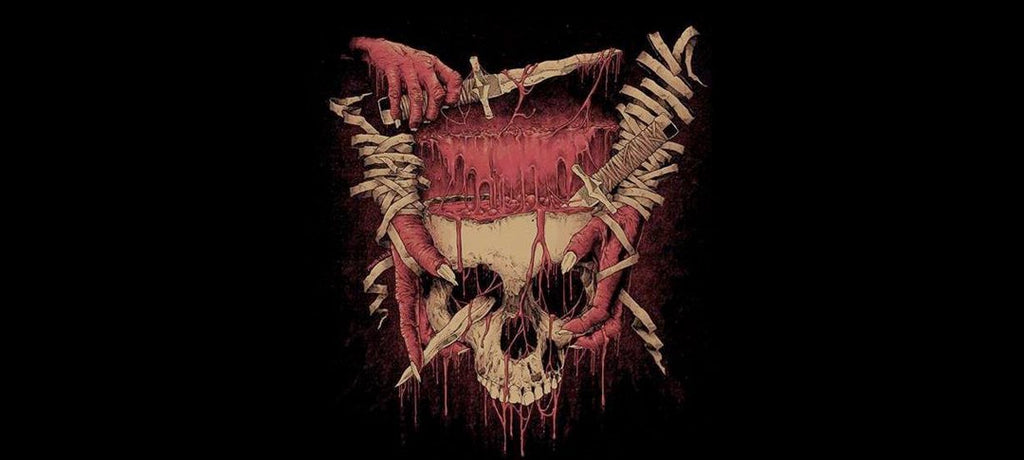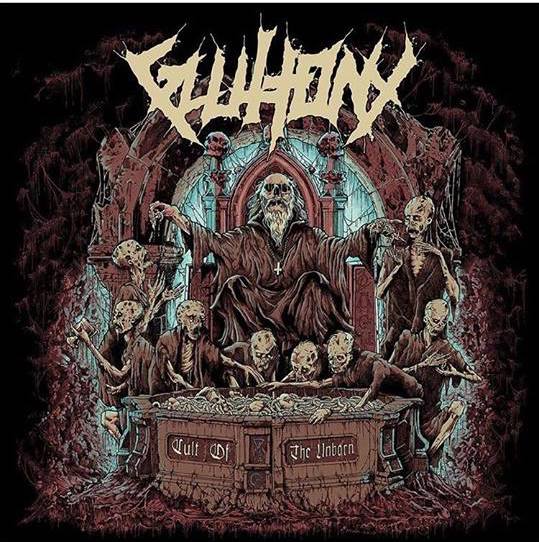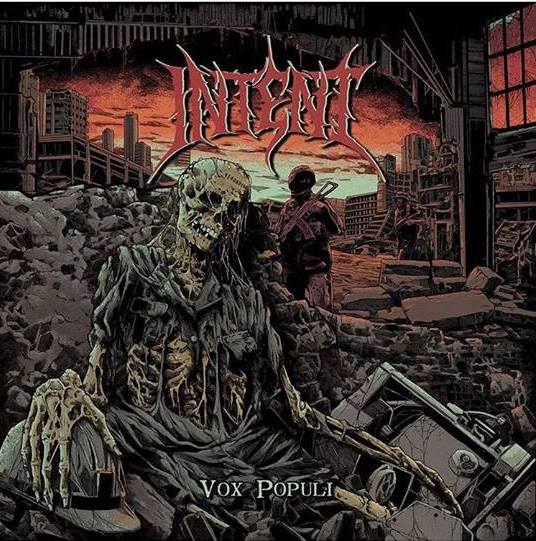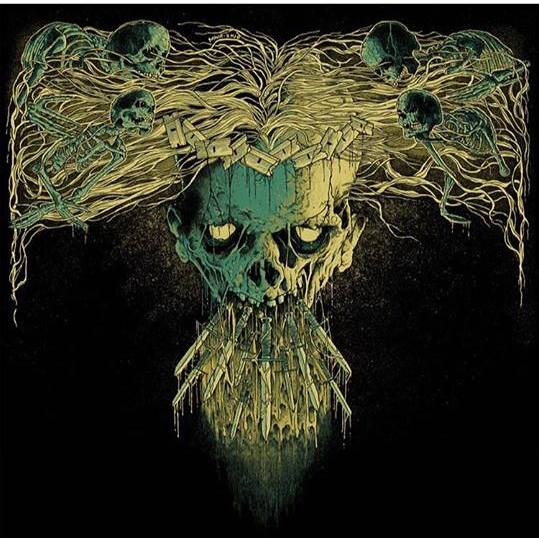
Mark Richards aka "Heavy Hand" is a classically trained illustrator who found his way into metal illustration. He has gone on to become one of the most prolific contemporary artists in the metal community, working with artists such as Aborted, Agoraphobic Nosebleed, Artificial Brain, Funebrarum, Iron Reagan, Revocation, Pig Destroyer, and many, many more. We got the distinct opportunity to talk with Richards about partying with Dan Seagrave, illustration career advice, and his music with the California-based artist.
Tell us the Heavy Hand creation story. How did you become a metal album illustrator?
Mark Richards: As I’m sure is the same story with most metal artists, it started in elementary or middle school, recreating my favorite bands’ logos and album covers; Black Sabbath, Slayer, Metallica, Megadeth, etc. Metal imagery looked so cool and different, and I wanted to know how it worked. When I eventually started playing in bands in high school, I would do the art, and friends wanted art for their bands. When I went to college I found any excuse to make metal-centric art for projects and it just kept snowballing from there.
What does the phrase dark art mean to you? Why do you think you gravitated towards it?
MR: To me, dark art is anything creepy, grotesque, evil, or terrifying. Strong dark art should be able to evoke and portray concepts, ideas, and emotions people would prefer to dismiss because they feel unsettled or disgusted. I think I gravitated towards dark art because I acknowledge that there’s a lot of darkness and morbidity in the world. Instead of ignoring the fact that we’re all going to be fertilizer one day, I’d rather embrace it and have fun. I’ve been exposed to horror movies and death metal album covers for as long as I can remember, so it could just be that dark imagery has been a constant in my life. And really, demons, hellscapes, skulls, and rotting flesh are way more fun to draw than anything else.
Do you take on commissions that aren't dark art related? Why or why not? If you do, why don't you show them?
MR: I’m always willing to take on commissions outside of my usual subject matter, as long as it’s a challenge, or at least fun. As much as I love drawing all sorts of messed up stuff, I also want to draw a portrait of someone’s puppy, dammit. It’s important for me to get out of my comfort zone sometimes; it helps create balance, allows me to grow as an artist, and makes me really appreciate the work I’m lucky to be doing. I’ll show some of the lighthearted stuff here and there, but only if I believe it’s up to par with the rest of my work. Sometimes clients prefer to keep their commissions private. This type of work gets lost in my usual shuffle of carcasses and creatures, so some of it gets overlooked easily.
What is your top ten list of greats that have inspired you?
MR: My inspirations change daily depending on what I’m doing, but the artists who have made the longest lasting impact on me are:
- Hieronymus Bosch
- Gustave Dore
- Bernie Wrightson
- Zdzislaw Beksinski
- Dan Seagrave
- Sam Kieth
- Wes Benscoter
- Mark Riddick
- Ralph Steadman
- Florian Bertmer
What was the moment you realized you could be a professional artist?
MR: To be perfectly honest, I don’t think I’ve become a professional artist yet, at least in terms of my expectations for myself. There have been many moments in the past five or so years when I thought, “This is what I can and should be doing for a living,” then almost immediately realizing all the things I would need to improve before making it happen. That said, the moment I realized I should drop everything and focus on becoming a pro was last July, shortly after getting pins put in my drawing hand due to breaking it in a mountain biking accident. I had to cancel a lot of work that I needed to fund a move across country in September, so it really put me in a shitty situation. Luckily my doctor cleared me to put some pressure on the hand once I got a hard cast, so I started to get back into drawing. It was painful and awkward as hell, but I managed to make an illustration for an Eyehategod poster that became my most popular piece at the time. Within a week or so I had accumulated two to three months worth of commissions, so I was feeling more confident than ever to quit my soul-crushing job and just draw forever.

How did you start illustrating for metal bands? How do you think you went from your first illustration to making the genre your bread and butter?
MR: In the beginning, it was just creating art for bands I played shows with, friends’ bands, and my own bands. It helped that there weren’t many other metal artists in my general area, and no social media to make it easy to find a million artists in a second. I became one of the go-to guys for a lot of bands via word-of-mouth, mainly for logos and simple t-shirt designs. Making metal art has always been the most fun for me, so I just didn’t stop, let bands know I was available, and made sure to evolve however I could. I never really thought it would become my bread and butter, but I’m happy it happened and continues to work for me.
What is a sure fire way to piss a potential client off as an illustrator?
MR: Since no one has ever told me straight up that I’ve pissed them off, I can only speculate, haha. I’ve heard bad stories from friends and clients about artists not acknowledging their ideas at all, not showing progress when it’s been requested, and ignoring strict deadlines. Something I’m sure that would piss off anyone is poor time management; I have to admit I’m guilty of taking a lot longer than I usually expect (mainly because I don’t envision myself doing things like drawing a full head of hair on a corpse for four hours), but I do my best to communicate that and not drop the ball completely.
Let's do the opposite - how can a potential client burn their Heavy Hand Illustration bridge?
MR: There are many ways to burn the bridge into Heavy Hand Land. Being undervalued is probably the biggest thing that fills me with art nerd rage. When a potential client hits me up with tons of praise, saying they love the piece I did for this band or that band, name my price, blah blah blah, and then try to lowball me with some ridiculous “offer” that’s a fraction of my quote, I see red. I can’t tell you how many times I’ve heard something like “well so-and-so said he could do the same thing for $25.” Fuck. Off. Fuck off as far as you can, and then fuck off some more. There’s usually a good reason that idiot is only charging $25. Money isn’t everything, and I’m not greedy, but this is my job and I’m not working my ass off for pennies. Another surefire way to piss me off is undermining my skills and vision, or expecting me to try emulating someone else’s style. The main reason people should be coming to me for work is because they enjoy what I do, and how I do it.

What are some of your career highlight clients that you've worked with?
MR: I would have to acknowledge Scott Hull of Pig Destroyer and Agoraphobic Nosebleed first and foremost. Scott is one of my favorite riff-writers, very down to earth, and trusts me to do pretty much anything I want. Of all the bands I’ve worked for, I’ve been listening to PD and ANB the longest. They’ve also consistently had some of the coolest visuals, so I feel honored to be among some of my favorite artists (Paul Booth, Florian Bertmer, John Dyer Baizely, Chris Taylor, etc.). There are a solid handful of other large, well-known bands I’ve been able to make art for, but in terms of my own personal musical preferences, Ghoul, Horrendous, Internal Bleeding, and Funebrarum were big highlights for me.
If you had your own chance to make your own homage to an album that's been influential as fuck to you, what would it be?
MR: Broken Hope’s Loathing, without question. I vividly remember scouring the used section of Newbury Comics in Hyannis, Massachusetts when I was maybe 15 or 16, and Loathing really stood out. I had never heard of them, but I loved the logo and I couldn’t mistake the Wes Benscoter cover art. It was only $5.99, so I had to take the chance, and I was blown away. Joe Ptacek’s inhuman gutturals were terrifying, the lyrical content was creepy, dark, and creative, and the riffs were so groovy and brutal. Almost 20 years later, it’s still my favorite death metal album and cover art.
What is one of your most memorable experiences from your career - funny, surreal, wild, totally open interpretation!
MR: I can’t really think of anything “funny” happening, but I’ve definitely had some surreal experiences. The first thing that comes to mind was Dan Seagrave coming to the Path Of Dissent show at Eridanos Gallery in Boston. It was an amazing time getting to talk with a hero, but it was even better when he offered me a beer, then later wanted to hang out and drink more. It was like the first time I shared a beer with my dad, if my dad painted the coolest death metal album covers. I have to credit Steph of Dark Art & Craft with making that moment happen! Oddly enough, the other strong memory I have was a few months later when Path of Dissent was installed for a one-night show at St. Vitus in Brooklyn.
The night before, I had been busting my ass to finish one of the absolute worst commissions I’ve ever taken on. When I was maybe an hour or so away from finishing at something like 5 AM, my desk collapsed, sending numerous bottles of ink and watercolor flying. The art was destroyed, I was out close to $100 worth of supplies, my apartment was a mess, and a few hours later our buddies Joe Gettler and Michelle Dugan were on their way to pick me up to go to the show in New York. I think I got an hour and a half of sleep that night (or morning I guess I should say), and only another two hours of sleep the following morning before heading into work at 6:30 a.m. I also broke up with my girlfriend at some point in the night, so it was a really good time. Overall, the worst/funniest part was having to redo that awful art, which I’ve never shared on social media and will regret making for the rest of my days.
Not only are you an illustrator, you also have been active as a musician in the New England metal scene. You working on anything currently?
MR: At the moment I have a ton of stuff written for various projects, but almost no time to really get anything off the ground due to all these damn illustrations, haha. Before I moved out to San Diego, I had a lot of stuff written for my last band Bacterial Husk, which will now be used for a death/thrash project in the same vein, tentatively called Carrion Vessel; Kyle, also formerly of Bacterial Husk, will be handling lead vocals. In addition, Kyle and I are working on a grind project called Infinite Loss. I’m hoping to get some sort of dirty, creepy-crawly death metal band going out here so I can play some shows again, but it’s tough since I don’t really know anyone from the metal scene.

How does working on music affect your illustrating? Averse? Positive? Can you tell us a little about that?
MR: Making music is a huge positive. Music and art are like yin and yang for me. When I’m feeling frustrated or need a break from one, I can bounce over to the other to clear my head and avoid any long stints of creative block. The only negative is that I can’t do both at the same time!
What is the weirdest piece you've illustrated?
MR: There are so many to choose from, but I did a shirt design a few months ago for U.K. band Gurt. They wanted a design for their song “Battlepants,” which is about a scantily clad barbarian. Part of the request was, and I quote, “we want the character to be wearing studded denim hot pants please!?” Runner up would be a butter-melting dragon for Seattle-area band Butter Boy’s album Melt.
You've been doing this for a while now. What do you think is the most over requested subject matter you get?
MR: Post-apocalyptic/dystopian cityscapes and zombies are probably tied. There was a point a few years ago during which I was turning down jobs left and right because it seemed like every band wanted the same thing. I don’t get as many requests anymore, but when I do I have to make sure I either offer up a unique approach or alternative. I don’t mean to diss anyone who wants these elements in their art, but an important aspect of my craft is to make sure I don’t make anything too generic. Not only do I want my art to look sweet, I want the bands I work for to stand out in a crowd.

What is the most difficult illustration you've ever had to do? Why?
MR: It would have to be the piece I referenced in the funniest experience question. I don’t want to openly talk shit about a client, so I won’t release the name or go into any specifics. The subject matter was extremely generic and boring, and the client just did not want to entertain any thoughts I had that would make the art better. I even showed him several pieces that had been released in the previous year or two that were almost identical to what he wanted. I powered through it reluctantly and even tried to sneak in some extra stuff to make it worth my while, but he still didn’t budge.
When I was nearing completion of the first version and the desk collapsed, I was so shocked and defeated that I couldn’t even react. The second version ended up taking way longer than the original, mainly due to the client wanting to see an unnecessary amount of changes and adjustments. It got to a point where I had to stick to my guns and firmly say no. One of the most frustrating parts of this whole experience is that I did make several changes he wanted to see, only to come back and say, “you know on second thought, you’re right… go back to the last version.” Once the illustration was finally locked down, what I thought would be a very simple layout turned into the nit-pickiest shitfest I’ve ever endured.
One specific question I received was, “do you think there’s too much space between the T and H in ‘the’ in that song title?” I’m way too nice in situations like this because I want to be as professional as possible, and it took me every ounce of willpower I had to not Hulk out and throw my computer through the window. I think what made this whole situation the most difficult in the long run is that a lot of people actually loved the piece when the band released it. It made me angry for the first time that no one would say my art sucked.
What are some of the most important things an illustrator can do to become successful?
MR: Having a strong foundation in all the basics is definitely a huge part of success; not all art has to be masterfully crafted, photorealistic, or hyper-detailed, but if you don’t have any technique or compositional skill, you’re not going to get far. The number one thing beyond the basics is being critical. If you can’t be critical of your own work, you’ll never get better. You can be happy with your work, but you have to be able to see where you can improve. I can’t think of a single piece I’ve created that doesn’t have several aspects I wish I did better. Instead of looking at it as a negative, I remember that stuff when I start the next piece and do my best to improve. This not only applies to skill and technique, but to concept, subject matter, and how you present yourself to the proper demographic.
You moved across the country recently from the east to the west coast. How has this move affected your career as an artist?
MR: My move to San Diego has been mostly great for life in general, but there’s been a great indirect effect on my career. It seems like it shouldn’t matter since I get the vast majority of my work from the internet, but being in this type of environment helps drive me forward. I was really feeling stressed and beaten down in the northeast. The inclement weather, destroyed roads, completely unpredictable stints of heavy traffic, unreliable public transportation, aggressive driving, shitty attitudes, cost/quality of living, and luxury condos replacing pretty much every square inch of the Boston area all crushed my spirits more and more everyday. Out here, it’s almost the exact opposite; people in general have a lot more positivity, drive, willingness to support their peers, and general pleasantness. The weather is 99 percent perfect, which I think has a huge effect on quality of life; the roads are intact, cars aren’t falling apart on the highway, there are no huge storms slowing everyone down. I’m sure I could be criticized for going soft or some shit like that, but it’s a lot easier to get into the right frame of mind when your surroundings are calm, welcoming, and full of other creative people who want to see you succeed.
What's on your drawing table right now? Are you at liberty to discuss some upcoming releases featuring your work that we should keep our eyes out for?
MR: At this very moment I’m completing a mini-tour poster for Boston-based bands Upheaval and Ritual Blade. I don’t know how specific I can get on other stuff, but the most exciting project is an officially licensed Army Of Darkness-related piece. The Evil Dead movies are my favorites of all time, so I’m shitting bricks over here. Another thing I’m very excited for involves Napalm Death, the band that really got me into underground metal/grind. I’m also working on several pieces for some well-known repeat clients, and of course drawing a shitload of skulls.

What is your advice to the budding artists out there?
MR: If art is truly what you want to do with your life, dedicate as much as you possibly can to it. Half-assed effort doesn’t work for anyone in any walk of life, so you have to be in it to win it. It’s going to suck a lot, you’ll probably be broke for a while, your hand, wrist, and forearm are going to hurt all the time; you’ll fall asleep at your drawing table and miss out on a lot of socializing with your family and friends. You’re definitely going to put countless hours into something that you end up trashing, or no one else likes. None of this sounds glamorous - because it isn’t - but it becomes rewarding when you see improvements, and other people start to notice the good, hard work you put in.
Make sure to follow him on Instagram, and check out his website for news, upcoming releases, and originals, prints and merch you can snag!

